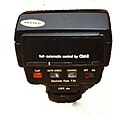Olympus OM-2
 Olympus OM-2 SP | |
| Overview | |
|---|---|
| Maker | Olympus |
| Type | 35 mm single-lens reflex (SLR) |
| Lens | |
| Lens mount | Olympus OM |
| Focusing | |
| Focus | Manual |
| Exposure/metering | |
| Exposure | 1/1000 ~ 1 s, bulb (B), aperture priority (Av) |
| Exposure metering | Off-the-film (OTF) TTL |
| Flash | |
| Flash | Hot shoe, PC socket |
The Olympus OM-2 is a single-lens-reflex film system camera produced by Olympus of Japan.
Main Features
The Olympus OM-2 is an aperture-priority automatic-exposure camera (with full manual operation selected via switch), based on the earlier, successful Olympus OM-1 body. The OM-2 was introduced in 1975,[1] and combined the light, sturdy camera body style of the manual-only OM-1 with a new automatic exposure system.
One of the main selling points of the OM-2 was that all of the OM-1 accessories and lenses would fit without modification, offering a complete photographic system which could be carried easily, and allowing OM-1 owners an easy upgrade path. Although the camera was promoted in photography publications and magazines as technically superior, Olympus as a company did not have the same recognition as Nikon or Canon and, as a result, some professionals considered the cameras inferior due to their lighter weight.[citation needed]
Technical details
Of the many features the OM-2 boasted, the most commonly advertised feature was that it was the first camera to offer a TTL direct metering system for film,[2] named Auto Dynamic Metering (ADM). This "off the film metering" was the first ever. Another feature of the OM-2 was the integration of two available electronic flash guns into the system.[3] The camera set the duration and intensity of the flash during exposure using its inbuilt sensors by measuring the amount of light reflected off the film. This ensured excellent results under difficult conditions. Exposure calculation was unique thanks to the twin "silicon blue cell" sensors which, for shutter speeds of 1/60s and above, measured light reflected off a graduated patterned surface on the lens side of the shutter. For shutter speeds below 1/60s, exposure was calculated from the amount of light reflected off the film surface during the exposure.[4] The shutter was a horizontal-running cloth type. In auto-exposure mode the camera was capable of giving exposures from 60s-1/1000s (OM-2N, 120s-1/1000s). The camera also offered a metered manual-exposure mode, with speeds of 1s-1/1000s, plus B.
Physical Appearance
The camera came in chrome or black finish. The later OM-2N was a slightly improved version. The OM-2SP (OM-2S in the USA) added a spot meter, Program mode and a new meter display with a through-lit LCD bar graph display instead of the 'old fashioned' needle.
-
Olympus OM-2 with Zuiko 24mm f/2.8 lens
-
Olympus new OM2 with a very compact zoom 35-70mm
-
Olympus new OM2
-
Dedicated TTL strobe T-32 for Olympus OM2
-
T-32
References
- ^ Functional Photography. Vol. 14–15. Photographic Applications in Science and Technology, inc. 1979. pp. 22–24.
- ^ http://www.olympus-global.com/en/corc/history/camera/om.cfm Olympus Official Historical Site
- ^ H. Greenwood, 1983. The British Journal of Photography. Liverpool Photographic Society.
{{cite book}}: CS1 maint: numeric names: authors list (link) - ^ Michael Mcbroom (2000). McBroom's Camera Bluebook: The Complete, Up-to-Date Price and Buyer's Guide for New and Used Cameras, Lenses, and Accessories. Amherst Media, Inc. ISBN 9781584280132.
External links
![]() Media related to Olympus OM-2 at Wikimedia Commons
Media related to Olympus OM-2 at Wikimedia Commons





